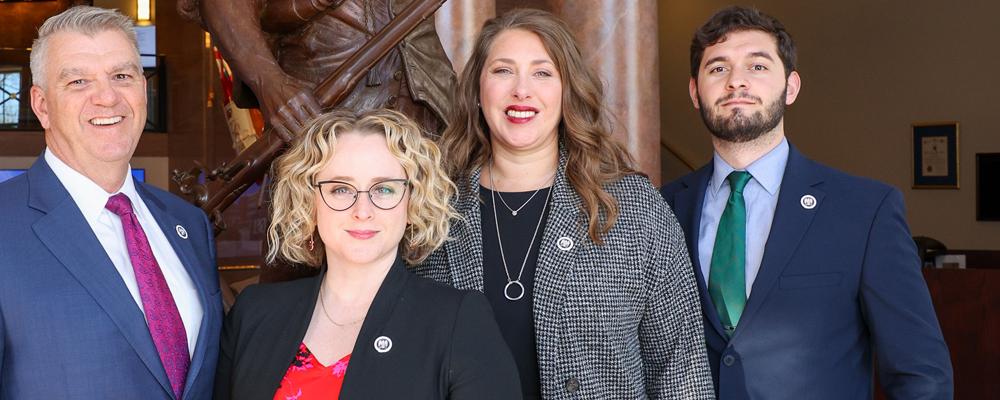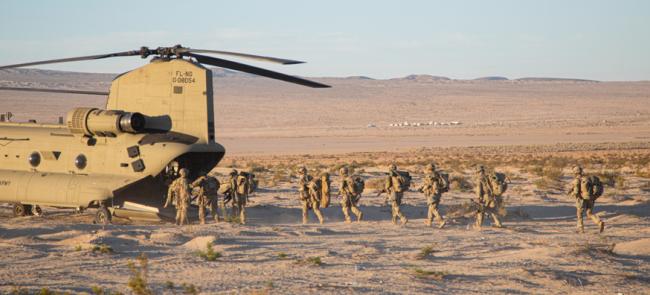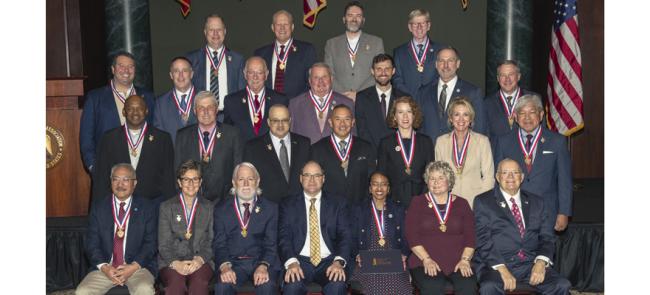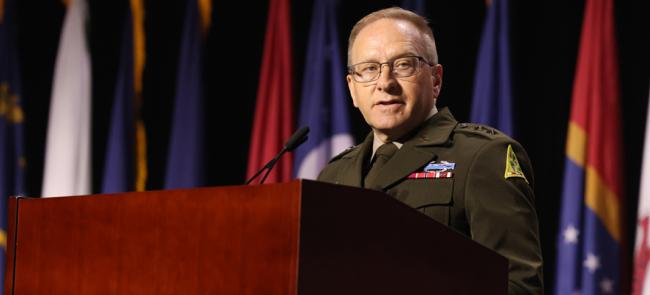
On Point
NGAUS wants America's best military training and equipment for the Army and Air National Guard.
“We never want to put Guardsmen in harm’s way without giving them an unfair advantage,” says retired Col. Mike Hadley, the association’s vice president for government affairs, who heads the association’s advocacy efforts on Capitol Hill.
Unfortunately, that wouldn’t be possible if the Guard had to rely solely on the resources requested for it in presidential budget proposals, he explains.
That means the Guard is reliant on Congress to add funds to final defense appropriations, which is where Hadley and the rest of the association’s legislative team comes in. They share the Guard’s unfunded requirements and other needs with lawmakers.
Last year, the effort helped convince Congress to add more than $4 billion to the president’s fiscal 2023 budget request for Army and Air Guard equipment. The package included new tanks, howitzers, helicopters, cargo planes and the Army Guard’s first MQ-1C Gray Eagle unmanned aerial system.
But even the record amount of so-called add-ons for Guard equipment won’t do much to the bottom line: The Army Guard’s eight combat divisions are not equipped and operated like the active-component divisions, and the Air Guard has the oldest aircraft in the Air Force fleet.
The disparity is a product of Army and Air Force budget processes that prioritize active units, sometimes at the expense of the Guard, says Hadley, who is intimately familiar with the practice, having worked it for many years in positions at the Pentagon and on Capitol Hill.
Active-component formations will be first to the fight is the logic, but Guard combat units also deploy to potential flashpoints worldwide, sometimes with less than the best equipment, he argues. They’re also critical to the overall National Defense Strategy and need to have the same equipment.
Two current NGAUS priorities are examples of the equipment disparity: Gray Eagles and C-130J Hercules cargo planes, he says.
Active-component Army divisions have had Gray Eagles for years. Service leaders consider them critical to pinpointing long-range fires. But the Army has never requested one for the Guard. So, last year, Hadley and his team worked with some adjutants general to get funds added to final defense appropriations to fund 12 Gray Eagles for the Guard, enough for one division.
The story is similar for the C-130J. Active-component Air Force C-130 units fly nothing but the latest variant of the venerable intra-theater cargo plane; however, the service has never included one for the Air Guard in a presidential budget request. Fortunately, NGAUS has been able to convince Congress to add 58 in recent years to final defense appropriations, but that’s not enough to replace all of the Guard’s 40-year-old H-models, which need extensive modernization.
The president’s fiscal 2024 budget request provides no help with either aircraft. Consequently, both are on the association’s must-have list this year. So are several other systems (see below).
Benefits that improve the lives of Guardsmen and their families are also among this year’s priorities. Association-inspired actions by Congress have closed the benefits gap between active and Guard and Reserve service in recent years as demands on the reserve components have increased. But true benefits parity has not been achieved.
Zero-cost TRICARE tops the list. It’s also a legislative priority for Gen. Daniel R. Hokanson, the National Guard Bureau chief, who says the NGB data shows that 16% of Guard soldiers and airmen have no medical coverage. That means they lack the ability to get the preventive health care so critical to medical readiness.
“When we have units with medical readiness rates of 60%, the level of assistance the Guard can provide is limited,” says Julian Plamann, the association’s legislative affairs manager for joint-personnel programs. “If the last three years has taught us anything, it’s that our communities rely on the National Guard to always be ready. This effort is a way in which Congress can help us help the nation.”
Hadley says the issue of health care has been around for a while, but it became more of a priority when the COVID-19 pandemic began in 2020.
“COVID really highlighted that, because we had thousands of Guardsmen deployed with no health care that were responding to a national medical emergency,” he says. “It became a deeper issue.”
Hadley expects to see legislation introduced this year in both the Senate and House that would provide zero-cost TRICARE medical coverage to every member of the Guard and Reserve.
We never want to put Guardsmen in harm's way without giving them an unfair advantage.
—Col. Mike Hadley (Ret.), the NGAUS vice president for government affairs
NGAUS LEGISLATIVE PRIORITIES are a product of a legislative resolutions process that begins in the 54 states, territories, and the District of Columbia.
State and territory Guard associations develop the resolutions at their conferences. They are geared to the next year’s session of Congress, which deliberates on the following fiscal year’s defense bills.
Draft resolutions go to NGAUS in Washington, D.C., for staff review and input from the association’s issue-oriented task forces and NGB. They are then forwarded to the annual NGAUS conference for consideration by representatives of every state and territory. Those passing are included in a package subject to a final vote of conference delegates.
The approved package typically includes hundreds of items. The NGAUS legislative team derives its priorities by working with the association’s 13 task forces, which are panels of subject matter experts from the Guard nationwide appointed by the NGAUS chairman.
The legislative team then delivers the priorities to Capitol Hill. They and retired Brig. Gen. J. Roy Robinson, the association president, meet with lawmakers, their staffs and the professional staffs of key defense committees, such as the Senate and House armed services committees and the defense subcommittees of the Senate and House appropriations committees.
Such meetings require significant research and preparation, Hadley says.
“We need to make sure that we’re not just blindly asking a congressional office for X or Y,” he explains. “It’s important to us that whenever we walk into a meeting, we know why the numbers are the way they are, we understand the ins and outs of everything we ask for. And we wouldn’t be able to do that without input from the Guard.”
Robinson and Hadley have also each testified before a congressional hearing this year.
Additionally, NGAUS teams with other advocacy groups that have an interest in helping the Guard. This includes the Association of the United States Army and the Air and Space Forces Association as well as the National Governors Association, the Adjutants General Association and the Enlisted Association of the National Guard of the United States.
The legislative team also works with the NGB Office of Legislative Liaison, individual adjutants general and their staffs on matters of interest to the 54.
As with all things, the needs of the Guard come down to the availability of resources. Sometimes, like last year, Congress is eager to add to the president’s budget proposal. In other years, Hadley says, it’s more of a zero-sum game, where lawmakers can increase appropriations to the Guard only by shifting money from someplace else in the budget.
In the end, the whole process can become a “grind,” with lots of follow-up calls, emails, texts and meetings. “It often comes down to relationships, knowing when to push and when to back off,” he says.
Every member of Congress has a Guardsman or Guard facility in their district.
—Marcy Weldin, the NGAUS legislative affairs manager for Army programs
THE TRUISM that all politics are local greatly aids in the effort, says Marcy Weldin, the legislative affairs manager for Army programs.
“Every member of Congress has a Guardsman or Guard facility in their district,” she says. “That gives us, as the association, a unique advantage when it comes to building relationships and lobbying Congress.”
Weldin formerly served as director of government affairs for the Texas National Guard, where she was the personal advisor to the adjutant general of Texas on legislative matters. She also spent time on Capitol Hill working with the Texas congressional delegation.
“My time in Texas gave me a strong baseline of knowledge on the Guard and specific issues to the state, but the ability to look across the country at the diverse equipment and mission sets the Guard operates and maintains was — and still is — appealing to me.”
Weldin said the relationships her department develops with members of Congress is important to how they do business.
“We are bipartisan — the message is the same regardless of political affiliation,” she says. “We get to have an opinion on behalf of our membership on the Hill, so when something is bad for the Guard we get to say so.”
It also helps that NGAUS is seen as a voice from the field, adds Plamann. “As a nongovernment entity, we have reach beyond the left and right limits of the National Guard Bureau to advocate for our members,” she says.
Before joining NGAUS, Plamann served as the House legislative director for NGB’s Office of the Legislative Liaison.
“I’m in the National Guard,” she says. “I know the importance of it, and I’m really passionate about policy. So, it kind of brings my two passions together. I am pushing issues that I know will positively affect our soldiers and airmen.”
Hadley, Plamann and Weldin, along with Robinson, are the registered lobbyists on staff, meaning they are legally allowed to advocate on behalf of NGAUS to every member of Congress. Hadley is in the process of adding an Air lobbyist to fill a recent vacancy.
The team is supported by a legislative analyst, Aubrey Powers, and a legislative assistant, Alec Gonzalez. Powers spends much of her time poring through often voluminous bills. Gonzalez helps organize the association’s semi-annual Capitol Summit for company-grade officers among other duties.

“The interesting thing about this job is that the work is never really done,” Gonzalez says. “We can get a legislative accomplishment, big or small, but then we have to come in tomorrow and keep working because there are still other priorities.”
{Main Photo [L to R:] Hadley, Plamann, Wedlin, Gonzalez}
Donald Lambert can be reached at [email protected].
2023 NGAUS Legislative Priorities
(For the deliberation of the fiscal 2024 defense authorization & appropriations acts)
To ensure deployability, interoperability and sustainability with the active component through:
The Same Organization
● Future multi-domain battlefield interoperability, including:
■ Deployable and interoperable force structure that is validated and doctrinally consistent
■ Space National Guard as the primary combat reserve component of the Space Force
■ Continued National Guard integration in the Total Force cyber mission and training
The Same Equipment
● Deployable, Interoperable and sustainable equipment
● Concurrent and proportional fielding of equipment, including:
■ UH-60M Black Hawk, MQ-1C 25M Gray Eagle, F-35A Lightning II, KC-46A Pegasus, C-130J Super Hercules and Future Vertical Lift procurement
● Equipment modernization and recapitalization, including:
■ AH-64E Apache, Humvee, M1 Abrams and M2 Bradley
■ A-10 Thunderbolt II, F-15 Eagle and F-16 Fighting Falcon
The Same Resources & Benefits
● Zero-cost TRICARE to ensure reserve-component medical readiness
● Post-9/11 GI Bill parity
● Robust National Guard & Reserve Equipment Account funding
● Tax incentives for Guardsmen and their employers
● Ready access to mental health care and suicide prevention
● Increased National Guard military-construction funding



